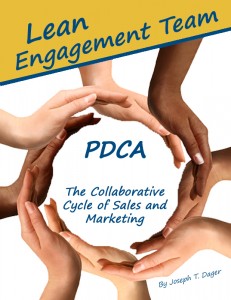 Sales and marketing can no longer operate in a vacuum. It has become a process output that intertwines across many of the departments within the organization. As companies have become flat, their decision making is increasingly being done by committee. As a supplier, you must mimic your customer decision-making path and as a result your sales and marketing will also be done by committee. Our highest priority is to deliver to the customer content that he deems valuable to his decision-making process.
Sales and marketing can no longer operate in a vacuum. It has become a process output that intertwines across many of the departments within the organization. As companies have become flat, their decision making is increasingly being done by committee. As a supplier, you must mimic your customer decision-making path and as a result your sales and marketing will also be done by committee. Our highest priority is to deliver to the customer content that he deems valuable to his decision-making process.
Lean is the future of marketing and one of the main reasons is the development of Agile under the Lean umbrella. Using the Agile Manifesto as a basis for Agile marketing or Lean marketing is a good start. In summary they are based on these principles:
- Individuals and interactions over processes and tools
- Content-rich material over elaborate promotion
- Customer collaboration over contract negotiation
- Response to changing customer needs over following a plan
Table of Contents
- The Path
- Positioning your organization from your customer’s viewpoint
- Only the Customer Determine Value
- PDCA from the Outside-In
- The iCustomer and iTeam
- New Lean Thinking
- Lean Engagement Tools
- Lean Engagement Team
- Marketing Gateway of EDCA, PDCA, SDCA
The further we are from our customers’ knowledge base the more effort has to be made to create a larger and larger supply of prospects. The ability to share and create knowledge with your customer is the strongest marketing tool possible. Successful Sales and Marketing are no longer trying to get their message out but developing strategies to get the message in.
Download the Lean Engagement Team PDF
SALES PDCA is the framework I use for the process that takes place in the customer sales and marketing cycle. It is a standard PDCA cycle except the SALES part of the framework is where the sales team gets its directions and coaching from the team coordinator and value stream manager. Within the actual PDCA stage the sales team is empowered to make their own choices and determine their own direction to accomplish the goals of that cycle. This framework is introduced in the Marketing with PDCA book.
Continuing with my Lean journey and the development of the Lean sales and Marketing platform, many of the PDCA cycles became standardized and SDCA was introduced. Graham Hill had mentioned the concept of EDCA (Explore-Do-Check-Act). Graham was the head of CRM at Toyota Financial Services. He stated that:
Marketing in highly competitive markets is about exploring new propositions on the innovation fitness landscape. The environment determines where to start and complex marketing environments need EDCA. EDCA = Explore, PDCA = Plan, SDCA = Standardize, marketing operations are all about moving along the EDCA>PDCA>SDCA pathway.
As a result it was refine into three separate distinctive cycles of SALES EDCA, SALES PDCA, SALES SDCA. Viewing your value stream/marketing cycle in this manner creates endless opportunities for improvement. It is also easier to handle the team concept of sales and marketing with this outline.
The Lean sales and marketing team is a cross-functional group whose number and expertise are derived from the decision-making path of the customer. You must first have established directives for a particular marketing cycle and a structure to match it. Are you looking for creativity (EDCA), problem resolution (PDCA), or tactical execution (SDCA)? Once you have established the objectives, you choose a team structure to match it. Without this process you may have creative teams working on tactical execution or on the other hand a problem-solving team working on a creative solution.
Download the Lean Engagement Team PDF
We concentrate on the development of a sales and marketing structure that can support customer engagement throughout the organization. This structure will be self-organizing at times and provide for customer touch points deep within the organization. Service Design, Open Innovation, Design Thinking and Lean provide a framework for organizing sales and marketing teams.
The question remained how do we make this knowledge explicit? Several years ago, I would have just framed this as an A3 report and placed the SALES on the left side and the ECA/PDCA/SDCA on the right side. However I have decided to use the terminology of a canvas versus an A3 following the concept developed in the Business Model Generation by Alexander Osterwalder. The BMG Canvas has its roots in Design Thinking which I believe is a better conduit for focusing outside the organization.
The BMGen Template brings the business components needed to the forefront and provide a one-page visualization of the process. It utilizes th e components of Design Thinking that I believe strengthens the connection with the customer for co-creation. It provides an excellent visualization tool for Value Stream Managers/Product Managers. .
e components of Design Thinking that I believe strengthens the connection with the customer for co-creation. It provides an excellent visualization tool for Value Stream Managers/Product Managers. .
When typical product-based organizations think of co-creation, they think of their engineers working with customers to develop their products in a more customer-friendly way. That is one way, but the real advantage in co-creation is the development of sustainable services through the use of your product. An example of this is Xerox’s managed print services that have won them long-term and profitable contracts with Sundstrand and Ingersoll Rand.
The Product Manager (VSM) is the key person in the organization that can accomplish this transformation. He provides the thought leadership, product knowledge, customer insights and level of authority needed. Without support at this key position, these ideas will prove to be just that, ideas!
Warning: Your Product Manager (VSM) must be trained and on board before attempting this transformation or it may be dangerous to the organization.
Download the Lean Engagement Team PDF
